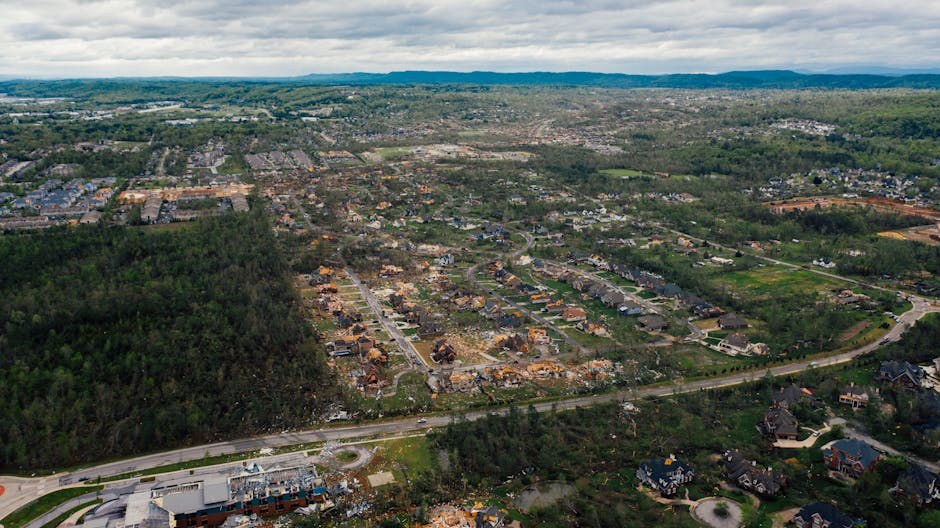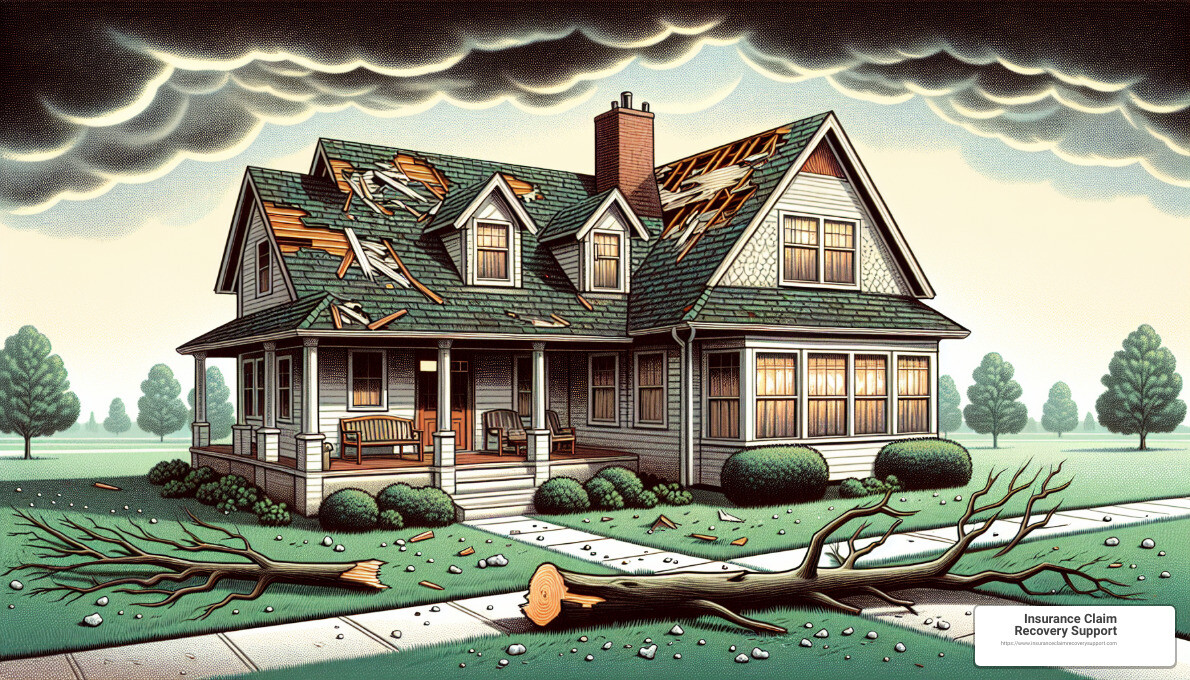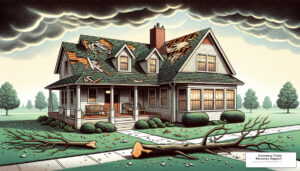Introduction
When it comes to Texas wind damage, the key is preparedness. This state is known for its severe weather patterns, including high winds that can cause devastating damage to properties ranging from residential homes to large commercial buildings. Whether you’re a homeowner association, a hospital, or run a government building, understanding the nature of wind damage and taking preventative measures is critical.
Wind damage in Texas isn’t just about the occasional broken window or downed fence; it can escalate to more severe structural damage, especially in wind-prone areas like North Texas where the weather can be particularly harsh. The force from these winds can tear off roofs, push over trees, and send debris flying, all of which pose serious risks to buildings and their occupants.
Preparedness starts with recognizing the potential threats and understanding how severe weather impacts your specific type of property. It involves regularly assessing your building’s ability to withstand these winds and implementing strategies to enhance its resilience.

By the end of this guide, you’ll have a clearer understanding of how to assess your property’s vulnerability to wind damage and the proactive measures you can take to minimize potential damage, ensuring the safety and integrity of your buildings against the fierce Texas weather.
Assessing Your Home’s Vulnerability to Wind Damage
To effectively protect your home from Texas wind damage, it’s crucial to assess various aspects of your property. Here’s a simple guide to evaluating your home’s vulnerability to wind damage, focusing on the roof, windows, landscape, and external structures.
Roof Inspection
Start with a thorough roof inspection. This is critical because the roof is often the first part of a home to suffer during high winds. Look for:
– Loose or missing shingles: These can be easily ripped off by wind, leading to more severe damage.
– Damaged flashing: This can allow water to enter the home during a storm.
– Blocked gutters: Ensure gutters are clear so water can flow away from your home, reducing the risk of water damage.
Consider scheduling an annual inspection with a professional to catch potential issues before they become major problems.
Window Durability
Windows are your home’s eyes to the world and need to be strong enough to withstand high winds. Check for:
– Old or worn-out seals: These can let in wind and water, causing internal damage.
– Cracks or chips in the glass: Even small imperfections can weaken windows.
Upgrading to impact-resistant windows is a wise investment in wind-prone areas, offering greater resistance to flying debris during a storm.
Landscape Risks
Your home’s surrounding landscape can pose a significant risk during high winds. To reduce this risk:
– Trim overhanging branches that could fall on your home.
– Secure or remove loose yard items like garden tools and patio furniture, as these can become projectiles in high winds.
External Structures
External structures such as garages, sheds, and fences also need attention. Assess their condition and stability:
– Check for weak points: Ensure that all structures are anchored securely to the ground.
– Inspect fences: Repair or reinforce weak sections that could collapse under wind pressure.
By taking these steps to assess and enhance the resilience of your home’s roof, windows, landscape, and external structures, you can significantly reduce the risk of Texas wind damage. This proactive approach not only protects your property but also ensures the safety of everyone inside during severe wind events.
Enhancing Roof Resilience Against Texas Wind Damage
Roofing Materials
Choosing the right roofing materials is crucial for enhancing the resilience of your home against Texas wind damage. Metal roofing, for example, is highly recommended due to its durability and ability to withstand high winds. It is essential to select materials that are specifically rated for high wind speeds, often indicated as having wind resistance up to or exceeding 120 MPH.
Installation Techniques
Proper installation is just as important as the materials themselves. Ensure that roofing materials are installed with a focus on wind resistance. Techniques such as using ring-shank nails, which have increased holding power compared to regular nails, can prevent shingles from being ripped off by strong winds. The edges of the roof should be securely fastened, as these areas are particularly vulnerable to high winds.
Regular Maintenance
Regular maintenance is key to ensuring that your roof can withstand severe weather. This includes annual inspections to identify and repair any loose or damaged shingles and tiles before they become a bigger problem. Homeowners should also keep gutters clean and in good repair to prevent water damage, which can weaken the roof structure over time.
Sargon Roofing & Restoration
For those in Texas, Sargon Roofing & Restoration offers specialized services to ensure your roof is prepared for high winds. They provide expert installation of wind-resistant roofing materials and can perform thorough inspections and maintenance. Their experience in dealing with Texas wind damage makes them a valuable resource for homeowners looking to enhance their roof’s resilience.
By investing in the right materials, ensuring proper installation techniques, and keeping up with regular maintenance, homeowners can significantly improve their roof’s ability to withstand the severe winds common in Texas. Sargon Roofing & Restoration stands ready to assist with professional advice and services tailored to protecting your home from the unpredictable Texas weather.
Fortifying Windows and Doors
When it comes to protecting your home from Texas wind damage, it’s crucial to focus on fortifying windows and doors. These are some of the most vulnerable parts of your home during high wind events. Here’s a straightforward guide on how to enhance their resilience.
Impact-Resistant Windows
Investing in impact-resistant windows is one of the most effective ways to safeguard your home. These windows are designed to withstand high winds and flying debris, which are common during severe storms. They feature a layer of polyvinyl butyral (PVB) or ethylene-vinyl acetate (EVA) between two sheets of glass, creating a strong barrier that holds the glass in place even upon impact.
Proper Sealing
Ensuring that all windows and doors are properly sealed is another essential step in wind-proofing your home. Gaps and cracks can allow wind to enter, increasing pressure inside the home and potentially leading to significant damage. Use weather stripping and caulking to seal these openings effectively. Regular checks are important, as seals can deteriorate over time.
Reinforcement Options
For added protection, consider installing storm shutters or panels. These can be made from various materials like metal, polycarbonate, or even plywood. Storm shutters provide an additional layer of defense against high winds, significantly reducing the risk of windows breaking. They can be permanent fixtures or designed to be installed easily whenever severe weather is forecast.
Houston Strong Roofing Company
For residents in Houston, the Houston Strong Roofing Company offers specialized services to fortify your home’s windows and doors against severe weather. They provide installation of impact-resistant windows and storm shutters, ensuring that your home is prepared to face the challenges of Texas wind damage. Their expertise in local building codes and weather patterns makes them a reliable partner in enhancing your home’s safety.
By taking these steps to fortify your windows and doors, you not only protect your property but also ensure the safety of everyone inside during extreme weather events. Next, we will explore how proper landscaping and secure outdoor structures can further mitigate the risks associated with high winds in Texas.
Landscaping and External Structures to Mitigate Texas Wind Damage
In Texas, where wind damage can be severe, it’s not just the buildings that need reinforcement. The landscaping and external structures around your home also play a crucial role in minimizing damage. Here’s how you can safeguard your property:
Tree Trimming
- Remove Weak Branches: Regularly inspect trees around your home and remove dead or weak branches. These can become dangerous projectiles during high winds.
- Professional Assessment: Consider hiring a professional arborist to assess tree health and stability. They can identify potential risks and recommend necessary actions to prevent tree fall that could damage your home or power lines.
Secure Outdoor Furniture
- Anchor Furniture: Use anchors to secure patio furniture, grills, and other movable items. This prevents them from being blown away or thrown against your home, causing damage.
- Storage Options: When warnings for high winds are issued, move smaller items like potted plants and lawn decorations into a shed or garage.
Fence Reinforcements
- Inspect and Repair: Regularly check your fences for loose sections or damaged posts. Repair or replace them as needed to ensure they can withstand strong winds.
- Upgrade Materials: If you live in a particularly wind-prone area, consider upgrading to heavier-duty fencing materials that offer better resistance against wind forces.
Detached Structures
- Foundation and Anchoring: Ensure that sheds, garages, and other detached structures are properly anchored to their foundations. Unsecured structures can be significantly damaged or can become hazards during storms.
- Roofing Considerations: Just like your home, ensure that roofing materials on detached structures are inspected and maintained. Use reinforced materials to prevent wind damage.
By implementing these strategies, you help create a safer environment for your home and its surroundings against the harsh impacts of Texas wind damage. Taking these precautions seriously enhances your property’s resilience, reducing potential damage and keeping your family safer during adverse weather conditions. Next, we will discuss how to prepare for wind storms with effective emergency planning.
Emergency Preparedness for Wind Storms
When preparing for wind storms, especially considering the risk of Texas wind damage, it’s crucial to have a solid emergency plan in place. This includes preparing emergency kits, establishing family communication plans, knowing evacuation routes, and organizing insurance documents. Here’s how to tackle each of these critical areas:
Emergency Kits
Always be ready. An emergency kit is essential and should include:
– Water and non-perishable food for at least 72 hours.
– First-aid supplies, medications, and personal hygiene items.
– Flashlights, batteries, and a weather radio to stay informed during power outages.
– Important documents like insurance policies, identification, and bank account records, stored in a waterproof, portable container.
Family Communication Plans
Communication during a storm is vital. Set up a plan that includes:
– Emergency contacts clearly listed for all family members, including local emergency services.
– A designated meeting point if separated during an evacuation.
– Check-in procedures to ensure that all family members are accounted for and safe.
Evacuation Routes
Know your way out. Before a storm hits:
– Identify multiple evacuation routes from your home and practice them with your family.
– Keep your vehicle fueled and ready in case of an immediate evacuation notice.
– Stay updated with local news or a trusted weather app to receive timely evacuation orders.
Insurance Documents
Having your insurance documents organized can expedite the claim process after damage. Ensure:
– All documents are easily accessible—consider keeping digital copies in a secure cloud storage.
– You understand your coverage—know what your policy covers in terms of wind damage and ensure it’s adequate for your area’s risk level.
By preparing thoroughly for wind storms, you not only safeguard your property but also ensure the safety and well-being of your family. Next, we will address some common questions homeowners have regarding Texas wind damage and how to manage its aftermath effectively.
Frequently Asked Questions about Texas Wind Damage
Can 70 mph winds cause damage?
Yes, winds as “low” as 70 mph can indeed cause significant damage. At this speed, you might see serious structural damage to roofs, including the loss of shingles and roof decking. Unsecured outdoor items like lawn furniture and garbage bins can become dangerous projectiles, and large tree branches may break off, potentially causing further damage to property and power lines.
What damage can 80 mph winds cause?
When wind speeds reach 80 mph, the potential for damage increases substantially. Homes can suffer from partial roof removal and significant damage to siding. Mobile homes, even those that are secured, are particularly vulnerable to overturning or sustaining severe damage. Additionally, such wind speeds can uproot trees and snap utility poles, leading to widespread power outages and blocked roads.
When was Texas last tornado?
Texas has a history of frequent tornado occurrences due to its geographical and climatic conditions. The most notable recent event was an EF3 tornado that struck Perryton, Texas, in June 2023. This powerful tornado resulted in three fatalities and caused extensive damage to approximately 200 homes, highlighting the severe impact that tornadoes can have in the region.
By understanding the types of damage that different wind speeds can cause and staying informed about recent severe weather events, residents can better prepare for and respond to storm threats. Next, we will delve into how Insurance Claim Recovery Support can assist homeowners in maximizing their insurance settlements and advocating effectively for policyholders.
Conclusion
As we wrap up our guide on preventative measures for Texas wind damage, it’s crucial to focus on the support available to you after a storm. At Insurance Claim Recovery Support, we stand ready to help you navigate the aftermath of severe weather events. Our commitment is to ensure you are not left to face the challenges alone.
Advocacy for Policyholders
Navigating insurance claims can be daunting, especially after experiencing wind damage. This is where our expertise comes into play. We advocate fiercely for our clients, ensuring that your voice is heard and your needs are prioritized. Our team understands the intricacies of insurance policies and we use this knowledge to advocate for your rights as a policyholder.
Maximizing Insurance Settlements
Our primary goal is to ensure that you receive the maximum settlement possible. We meticulously document all damages and negotiate with insurance companies on your behalf. Our expertise in handling claims specifically related to Texas wind damage allows us to efficiently manage and maximize your claim. We ensure that all damages, both visible and potential future issues, are accounted for.
At Insurance Claim Recovery Support, we are more than just a service; we are your partner in recovery. We understand the stress and disruption that wind damage can cause, and we strive to make the claim process as smooth and stress-free as possible.
The right preparation and the right support can make a significant difference in how effectively you can handle and recover from Texas wind damage. Let us help you ensure that your home is not only prepared for the next storm but that you also have the necessary support to recover swiftly and completely. Learn more about how we can help.








